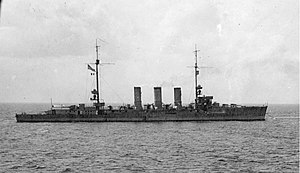 SMS Frankfurt as a target ship
| |
| History | |
|---|---|
| Name | Frankfurt |
| Namesake | Frankfurt |
| Builder | Kaiserliche Werft, Kiel |
| Laid down | 1913 |
| Launched | 20 March 1915 |
| Commissioned | 20 August 1915 |
| Fate | Ceded to the United States after World War I |
| Name | USS Frankfurt |
| Acquired | 11 March 1920 |
| Commissioned | 4 June 1920 |
| Fate | Sunk as a target, 18 July 1921 |
| General characteristics | |
| Class and type | Wiesbaden-class light cruiser |
| Displacement |
|
| Length | 145.3 m (477 ft) |
| Beam | 13.9 m (46 ft) |
| Draft | 5.76 m (18.9 ft) |
| Installed power |
|
| Propulsion |
|
| Speed | 27.5 knots (50.9 km/h) |
| Range | 4,800 nmi (8,900 km; 5,500 mi) at 12 kn (22 km/h; 14 mph) |
| Crew |
|
| Armament |
|
| Armor |
|
SMS Frankfurt was a light cruiser of the Wiesbaden class built by the German Kaiserliche Marine (Imperial Navy). She had one sister ship, SMS Wiesbaden; the ships were very similar to the previous Karlsruhe-class cruisers. The ship was laid down in 1913, launched in March 1915, and completed by August 1915. Armed with eight 15 cm SK L/45 guns, Frankfurt had a top speed of 27.5 knots (50.9 km/h; 31.6 mph) and displaced 6,601 t (6,497 long tons; 7,276 short tons) at full load.
Frankfurt saw extensive action with the High Seas Fleet during World War I. She served primarily in the North Sea, and participated in the Bombardment of Yarmouth and Lowestoft and the battles of Jutland and Second Heligoland. At Jutland, she was lightly damaged by a British cruiser and her crew suffered minor casualties. At the end of the war, she was interned with the bulk of the German fleet in Scapa Flow. When the fleet was scuttled in June 1919, Frankfurt was one of the few ships that were not successfully sunk. She was ceded to the US Navy as a war prize and ultimately expended as a bomb target in tests conducted by the US Navy and Army Air Force in July 1921.